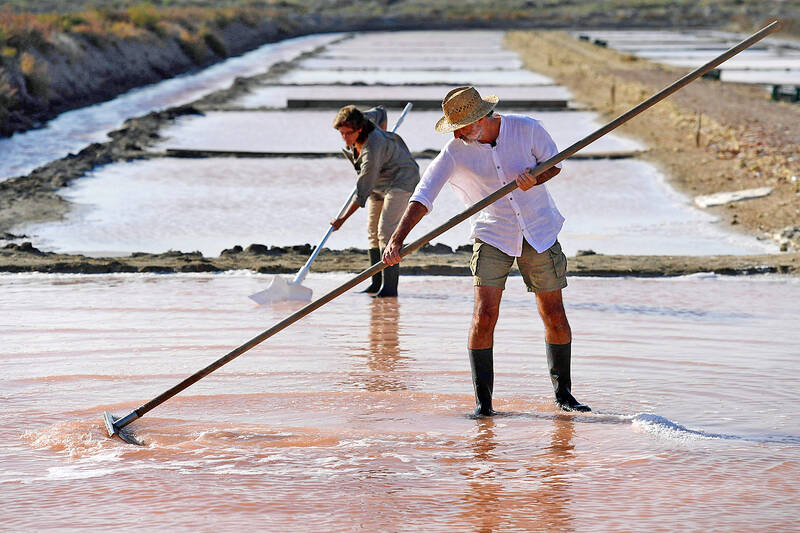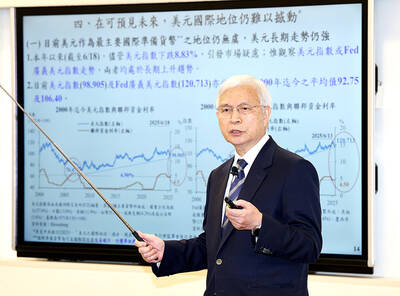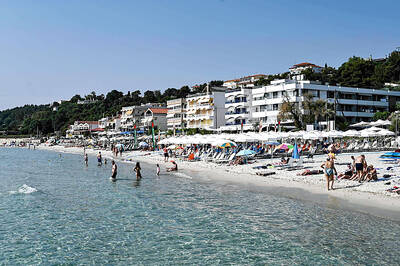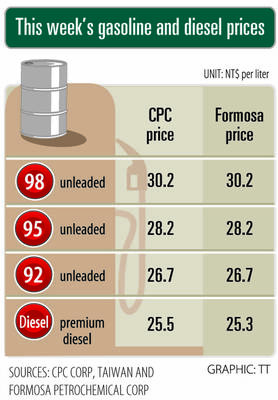In the salt marshes of Cadiz in southwestern Spain, Juan Carlos Sanchez de Lamadrid surveyed a grid of rectangular pools of milky water, part of a time-honored tradition to harvest salt from the sea.
Civilizations as old as the Phoenicians who ruled the Mediterranean from about 1,200 BC have taken advantage of the constant and strong winds that blow from North Africa, facilitating the evaporation of seawater to produce salt in the region.
“This is the perfect place for salt marshes. It’s windy, there is lots of sunshine ... you have everything you need,” said De Lamadrid, wearing a straw hat to protect himself from the blazing sun.

Photo: AFP
The 56-year-old, originally from Seville, is part of a small but dynamic group of artisans trying to keep the tradition of sea salt harvesting alive.
The sector flourished in this sunny region for centuries, with salt from Cadiz exported to the Americas, until the invention of refrigeration drastically reduced the need for salt to conserve foods.
Of the 160 sea salt producers that existed at the beginning of the 20th century, only four are still operating.
After a long career as a photographer and drawn by the beauty of the salt marsh landscapes, De Lamadrid set up shop in the region in 2020, becoming a sea salt harvester alongside his wife and two employees.
“We had to learn everything, we were starting from zero,” he said, adding that he learned the techniques from one of the few veteran harvesters who are still active.
He said he also spent time in Portugal and France “to discover other techniques.”
Last year they produced 30 tonnes of virgin sea salt and three tonnes of fleur de sel — or “flower of salt” — large salt crystals used to garnish and season everything from fish, meat and vegetables to desserts and baked goods.
HARVESTING BY HAND
To harvest the salt, sea water from the Atlantic is flushed into a network of reservoirs built in the salt marshes and is then allowed to evaporate.
When the salt in the water reaches the right concentration, it forms white crystals that workers then rake into small white heaps.
“We harvest everything by hand in the traditional way,” De Lamadrid said.
When salt demand fell with the advent of refrigeration, Cadiz “didn’t know how to adapt,” unlike places such as Guerande in northwestern France which started selling fleur de sel and other products, said Juan Martin, president of Salarte, a non-profit that works to revive the sea salt industry.
Since it was founded in 2012, Salarte has refurbished 250 hectares of salt flats using private financing.
“Some salt marshes were in a really poor state,” said Martin, a marine biologist.
He said that places such as the Bay of Cadiz are not valued enough for their ecological importance.
“It’s a shame because the marshes are real treasures” not only as a source of economic activity, but also for their extraordinary biodiversity, Martin said, using binoculars to watch migrating birds feeding at a recently restored salt flat.
NATURAL PANTRY
The revival of the salt industry is one of a string of initiatives over the past decade, from ecotourism to the cultivation of oysters, samphire and locally produced cosmetics, to breathe new life into the salt marshes which are part of a 10,500 hectare natural park.
The marshes — home to sea beam, shrimp and clams — are “an extraordinary pantry,” said chef Angel Leon, whose restaurant Aponiente, which is in a 19th-century tide mill and holds three Michelin stars, serves up dishes based on such ingredients and uses the local sea salt.
“Salt is something we use every day, but which we don’t fully appreciate,” the 46-year-old said.
Artisanal sea salt has a texture and taste which is “nothing like” industrial salt, he said.
“The problem is that we don’t pay it enough attention,” he said, adding that he hoped Cadiz sea salt would soon find its way into top restaurants around the world.

NOT JUSTIFIED: The bank’s governor said there would only be a rate cut if inflation falls below 1.5% and economic conditions deteriorate, which have not been detected The central bank yesterday kept its key interest rates unchanged for a fifth consecutive quarter, aligning with market expectations, while slightly lowering its inflation outlook amid signs of cooling price pressures. The move came after the US Federal Reserve held rates steady overnight, despite pressure from US President Donald Trump to cut borrowing costs. Central bank board members unanimously voted to maintain the discount rate at 2 percent, the secured loan rate at 2.375 percent and the overnight lending rate at 4.25 percent. “We consider the policy decision appropriate, although it suggests tightening leaning after factoring in slackening inflation and stable GDP growth,”

DIVIDED VIEWS: Although the Fed agreed on holding rates steady, some officials see no rate cuts for this year, while 10 policymakers foresee two or more cuts There are a lot of unknowns about the outlook for the economy and interest rates, but US Federal Reserve Chair Jerome Powell signaled at least one thing seems certain: Higher prices are coming. Fed policymakers voted unanimously to hold interest rates steady at a range of 4.25 percent to 4.50 percent for a fourth straight meeting on Wednesday, as they await clarity on whether tariffs would leave a one-time or more lasting mark on inflation. Powell said it is still unclear how much of the bill would fall on the shoulders of consumers, but he expects to learn more about tariffs

Greek tourism student Katerina quit within a month of starting work at a five-star hotel in Halkidiki, one of the country’s top destinations, because she said conditions were so dire. Beyond the bad pay, the 22-year-old said that her working and living conditions were “miserable and unacceptable.” Millions holiday in Greece every year, but its vital tourism industry is finding it harder and harder to recruit Greeks to look after them. “I was asked to work in any department of the hotel where there was a need, from service to cleaning,” said Katerina, a tourism and marketing student, who would

i Gasoline and diesel prices at fuel stations are this week to rise NT$0.1 per liter, as tensions in the Middle East pushed crude oil prices higher last week, CPC Corp, Taiwan (台灣中油) and Formosa Petrochemical Corp (台塑石化) said yesterday. International crude oil prices last week rose for the third consecutive week due to an escalating conflict between Israel and Iran, as the market is concerned that the situation in the Middle East might affect crude oil supply, CPC and Formosa said in separate statements. Front-month Brent crude oil futures — the international oil benchmark — rose 3.75 percent to settle at US$77.01